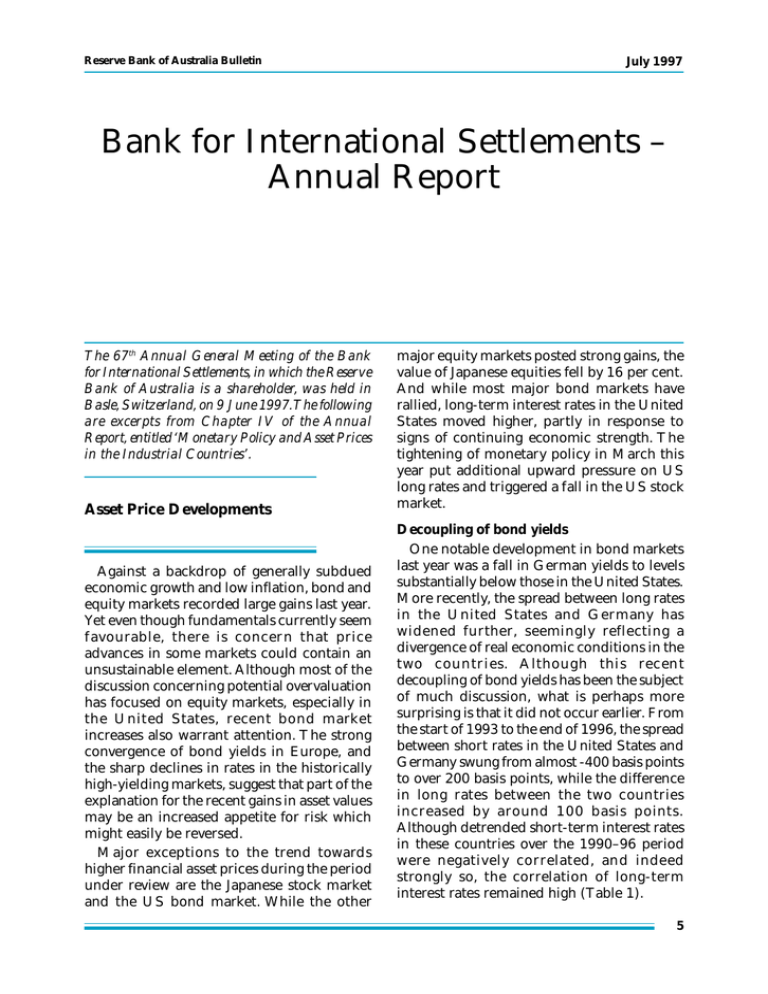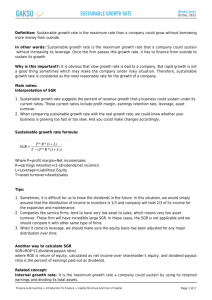Bank for International Settlements – Annual Report
advertisement

Reserve Bank of Australia Bulletin July 1997 Bank for International Settlements – Annual Report The 67th Annual General Meeting of the Bank for International Settlements, in which the Reserve Bank of Australia is a shareholder, was held in Basle, Switzerland, on 9 June 1997.The following are excerpts from Chapter IV of the Annual Report, entitled ‘Monetary Policy and Asset Prices in the Industrial Countries’. Asset Price Developments Against a backdrop of generally subdued economic growth and low inflation, bond and equity markets recorded large gains last year. Yet even though fundamentals currently seem favourable, there is concern that price advances in some markets could contain an unsustainable element. Although most of the discussion concerning potential overvaluation has focused on equity markets, especially in the United States, recent bond market increases also warrant attention. The strong convergence of bond yields in Europe, and the sharp declines in rates in the historically high-yielding markets, suggest that part of the explanation for the recent gains in asset values may be an increased appetite for risk which might easily be reversed. Major exceptions to the trend towards higher financial asset prices during the period under review are the Japanese stock market and the US bond market. While the other major equity markets posted strong gains, the value of Japanese equities fell by 16 per cent. And while most major bond markets have rallied, long-term interest rates in the United States moved higher, partly in response to signs of continuing economic strength. The tightening of monetary policy in March this year put additional upward pressure on US long rates and triggered a fall in the US stock market. Decoupling of bond yields One notable development in bond markets last year was a fall in German yields to levels substantially below those in the United States. More recently, the spread between long rates in the United States and Germany has widened further, seemingly reflecting a divergence of real economic conditions in the two countries. Although this recent decoupling of bond yields has been the subject of much discussion, what is perhaps more surprising is that it did not occur earlier. From the start of 1993 to the end of 1996, the spread between short rates in the United States and Germany swung from almost -400 basis points to over 200 basis points, while the difference in long rates between the two countries increased by around 100 basis points. Although detrended short-term interest rates in these countries over the 1990–96 period were negatively correlated, and indeed strongly so, the correlation of long-term interest rates remained high (Table 1). 5 July 1997 Bank for International Settlements – Annual Report (a) Table 1: Correlation of Long and Short-term Interest Rates United States versus Germany 1975–79 1980–84 1985–89 1990–96 Long-term Short-term 0.52 0.80 0.65 0.74 0.81 0.60 United States versus Japan 1975–79 1980–84 1985–89 0.61 -0.57 0.19 0.73 0.40 0.33 0.67 0.30 1990–96 0.52 0.11 (a) Between detrended interest rates calculated as the difference between the actual interest rates and the uncentred moving averages over the past two years. Sources: National data and BIS calculations The generally high degree of co-movement of long-term interest rates in the three largest economies over the 1990–96 period, despite substantial divergences in cyclical positions, has led to concern that, even under floating exchange rates, international factors might overshadow domestic considerations in the determination of long rates. An implication of this view is that the link between policy rates and longer-term rates might be weakened. This would complicate the conduct of monetary policy in countries where long rates play an important role in the transmission mechanism. However, an alternative explanation for the divergence of short and long-term rates in Germany has also been suggested which relies on more local considerations: the rise in German long rates during a period of economic weakness reflected a concern that the euro might be a weaker currency than the Deutsche mark. The recent decoupling of rates in the United States and Germany perhaps indicates a revision of views in this regard, or a downward revision of expected future short rates in Germany for other reasons. Equity markets Stock prices set new records last year, with equities in the Netherlands, Spain and Sweden recording the largest gains during the period under review (Graph 1). In most instances Graph 1 Equity Prices Monthly averages, December 1995 = 100 Index Netherlands Index Germany Spain 140 140 Canada France 120 120 US Belgium Japan 100 100 UK Switzerland Italy 80 80 of which: Banks 60 1996 Source: National data 6 1997 1996 1997 1996 1997 60 Reserve Bank of Australia Bulletin July 1997 these sharp gains also came after large, cumulative increases in the previous four or five years. The major exception to the trend towards higher share values is Japan, where concerns about the impact of fiscal tightening on growth prospects and uncertainty over the impact of prospective financial deregulation have put downward pressure on equity prices. Japanese bank shares have been especially hard hit. One important factor contributing to the recent decline has been the unwinding of cross-shareholdings following the decision of the authorities not to rescue the shareholders of the failed Hanwa Bank. In some cases, recent advances in equity prices have been supported by strong growth of corporate earnings. In Sweden, for example, earnings per share grew by 41 per cent per year between the end of 1993 and the end of 1996. The United States also enjoyed very strong earnings growth over the same period. An appreciating US dollar has contributed to profit growth in some markets. Multinational firms with substantial direct investment in the United States or a large share of their earnings denominated in US dollars account for a large proportion of the equities traded on, for instance, the German, Dutch and Swiss stock exchanges. Another factor supporting corporate profits has been greater attention to strengthening efficiency and labour productivity as well as reduced financing costs arising from lower nominal interest rates. However, there is more to the generalised run-up in share prices than strong corporate profits. As of March 1997, price/earnings ratios for most markets, including the United States, were above their 1986–95 averages, and were at record levels in the Netherlands and Switzerland (Table 2). Several factors have been suggested as potentially underlying the global trend towards higher price/earnings multiples. First, it has been suggested that this trend might reflect the impact of lower inflation rates in the industrial countries on equity risk premia. Secondly, insofar as the recent declines in nominal bond yields reflect lower real interest rates, this is an additional element supporting higher multiples which has undoubtedly played a role in the historically high-yielding countries Italy and Spain. Thirdly, in the United States in particular, higher multiples might reflect to some extent the increased tendency for corporations to buy back their own shares. Table 2: Price/Earnings Ratios Countries Sep 1987 (b) Peak 1986–95 Level Date (a) Average Dec Dec Mar Memo item: 1986–95 1995 1996 1997 output gap 1987:Q3 1996:Q4 United States Japan Germany France Italy United Kingdom Canada 22 70 15 14 15 17 18 26 74 25 19 29 21 33 May 92 June 87 Dec 93 Jan 94 May 94 Feb 94 Feb 94 18 53 15 12 17 15 17 18 67 16 13 14 16 15 21 57 17 17 17 16 20 21 51 20 18 19 16 21 0.3 -2.9 -1.7 -2.2 -0.5 3.5 2.1 0.2 -2.3 -1.1 -3.0 -1.5 -1.8 -3.1 Netherlands Switzerland Belgium Sweden 15 14 15 23 18 19 20 30 Feb 94 Feb 94 Feb 94 Feb 94 12 13 14 18 13 17 14 17 18 20 16 15 20 23 18 17 -0.7 -1.2 -2.6 3.8 -0.2 -4.2 -3.0 -1.5 (a) Ratio of price to reported earnings per share. (b) Month preceding the global stock market crash. Sources: Datastream, OECD, national data and BIS estimates 7 July 1997 Bank for International Settlements – Annual Report Recent price/earnings multiples seem more pronounced once business cycle positions are taken into consideration. Multiples typically peak during the early stages of a cyclical recovery, when there is the potential for aboveaverage profit growth over the medium term. By this standard, the price/earnings multiples for the Dutch and US markets during March 1997 seem relatively high by historical standards, given that both economies were operating approximately at potential. It may also be useful to compare the recent situation with that which prevailed in September 1987. The price/earnings ratio for the US market at that time was not exceptionally high; yet US equities lost about 30 per cent of their value in the subsequent global market correction. In March 1997, price/earnings multiples in Germany, France, Belgium and the Netherlands exceeded those of September 1987, a time when each of these countries was at a point in the business cycle broadly similar to that reached recently (Graph 2). Whether the recent gains in equity prices will prove to be sustainable will depend in part on the future course of corporate profits. Analysts are forecasting earnings growth in the United States of 13 per cent per year on average over the next three to five years. It is argued that there are many factors, in addition to the cyclical position of an economy, which help determine the growth of corporate profits, and there are indications that such factors are currently playing a greater role than previously. In particular, since the closing of the output gap in 1994, the United States has experienced earnings growth far in excess of that which followed previous such closures (Table 3). Aggressive corporate cost-cutting, an increased rate of technological advance reflected in reduced costs of capital goods, and the opening-up of new markets are several possibilities which are often cited to explain recent earnings growth and to justify its expected continuation. The sustainability of the recent gains in equity prices will also depend on how far other supporting factors, such as the appreciation of the US dollar in 1995–96, prove to be temporary. Further increases in long-term interest rates outside the United States or a reduced willingness of market participants to take on risk would also put downward pressure on share prices. Any significant tightening of US monetary policy would be likely to work in this direction. Asset Prices and Monetary Policy There are several reasons why central banks might wish to respond to movements in asset prices. A first reason is that asset price misalignments may endanger the health of the financial system. In the late 1980s many countries experienced sharp increases in prices of real and financial assets, which were (a) Table 3: Real Earnings per Share in the United States Period Growth over three years(c) Growth over six years(c) (b) 1965:Q4 1972:Q2 1977:Q1 1985:Q2 1994:Q3 0.2 -3.7 4.7 3.2 3.3 -4.0 0.6 0.1 15.4(d) — (a) Earnings per share deflated by the consumer price index. (b) Quarter of estimated closure of the output gap. (c) From the respective reference period, at an annual rate, in percentages. (d) Growth between the third quarter of 1994 and the first quarter of 1997. Sources: OECD, national data and BIS estimates 8 Reserve Bank of Australia Bulletin July 1997 Graph 2 Output Gap and Price/Earnings Ratio % Japan US % Germany 10 30 5 20 0 10 -5 0 Italy France UK 10 30 5 20 0 10 -5 0 Belgium Switzerland Netherlands 10 30 5 20 0 10 -5 0 91 94 97 91 94 97 91 94 97 Price/earnings ratio (RHS) Output gap (LHS) * The price/earnings ratio is shown at half the actual level Sources: Datastream, OECD Economic Outlook, national data and BIS calculations associated with financial deregulation and rapid credit expansion. When these increases later proved unsustainable, large-scale losses were incurred in the banking sector, which deepened recessions and delayed recovery. While this episode illustrates the risks involved in disregarding asset prices in the formulation of policy, it should be recognised that the recent upswing is limited to financial assets and has not been accompanied by rapid credit growth, suggesting that balance sheets would be less exposed if asset prices reversed course. Furthermore, to the extent that policy-makers’ concerns focus on the impact on the financial system of a sudden asset price fall, a tightening of prudential supervision and regulation would appear to be a more appropriate measure than adjustment of policydetermined interest rates. 9 Bank for International Settlements – Annual Report A second reason why central banks might wish to respond to asset prices is that they potentially play an important role in the transmission mechanism. Rising asset prices may have direct effects on the demand for goods and services and may therefore be associated with growing inflationary pressures. Thus, asset prices, in particular for real estate, which is the main component of household net worth, can affect household wealth and consumption expenditure, and influence the ability of enterprises to raise funds and thereby their investment spending. They also influence collateral values and banks’ willingness to lend. The importance of asset prices became evident last year in the United Kingdom and the Netherlands, where increases in household wealth were an important force behind consumer spending. In practice, however, policy-makers may hesitate to let policy react too vigorously to asset price changes. One particular problem is that it is difficult to determine why these changes have occurred and whether or not there are likely to be effects on spending. Indeed, in many countries the stock market decline in 1987 seems to have had little impact on consumer spending. Moreover, since asset prices depend strongly on expectations of future economic conditions, it is difficult to judge how they will respond to policy action. For example, an unexpected shift in policy could elicit a much sharper response than a change that was anticipated. This underlines the desirability of signalling policy intentions to financial markets, particularly when the direction of policy is altered. Furthermore, since asset prices are determined by expectations far into the future, the possibility of perverse reactions to policy also needs to be taken into account. For instance, a 10 July 1997 tightening of monetary policy could lead market participants to revise upwards their assessment of the prospects for sustainable non-inflationary growth, and thus actually lead to increases in current asset prices. A third reason why asset prices might be useful for the design of policy is that they contain information about financial market expectations of future policy and macroeconomic conditions. For example, there is much evidence that the slope of the yield curve contains information about expectations regarding monetary policy, economic growth and inflation. Since financial market responses to anticipated policy changes are normally limited, policy may be altered more quickly in situations where asset prices, such as bond yields and exchange rates, indicate that policy changes have already been discounted in the markets. However, while asset prices may be useful as indicators, gearing policy directly to them could give rise to self-validating asset price movements. For instance, if central banks interpreted an increase in long-term interest rates as evidence of rising inflationary expectations and thus as warranting a tightening of policy, the policy action would validate the initial rise in long yields. It could therefore trigger further increases in long rates, which in turn could lead to additional increases in short interest rates which would not be justified by underlying economic conditions. While it thus seems inappropriate to react automatically to asset prices, the information that may be contained in them can be incorporated in the central bank’s forecast of future economic conditions, and in this way play some role in the formulation of policy.





